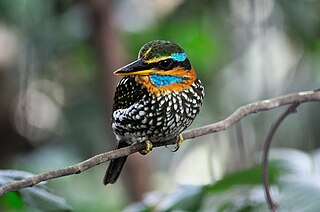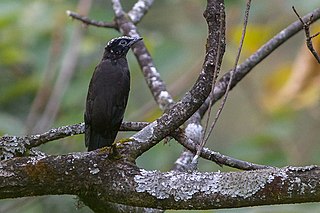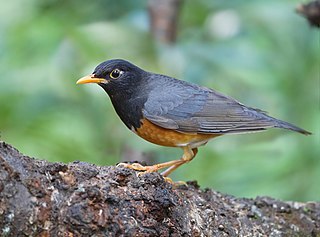
The blue manakin or swallow-tailed manakin is a small species of bird in the family Pipridae. It is found mainly in the Atlantic Forest of south-eastern Brazil, eastern Paraguay and far north-eastern Argentina. Its typical habitat is wet lowland or montane forest and heavily degraded former forest. Males have a bright blue body, black head wings and tail and a red crown. Females and juveniles are olive-green. At breeding time, males are involved in lekking behaviour when they sing and dance to impress females. This is a common species with a wide range, and the International Union for Conservation of Nature has rated its conservation status as being of "least concern".

The violet cuckoo is a species of cuckoo in the family Cuculidae.

Madarasz's tiger parrot is a species of parrot in the family Psittaculidae native to New Guinea. Its natural habitat is subtropical or tropical moist montane forests.

The moustached kingfisher, also called Bougainville moustached kingfisher, is a species of bird in the family Alcedinidae. It is endemic to Bougainville Island in Papua New Guinea. An estimated 250–1,000 mature individuals are left.

The spotted wood kingfisher or spotted kingfisher is a species of bird in the family Alcedinidae. It is endemic to the Philippines where its natural habitat is subtropical or tropical moist lowland forests.

The green-tailed sunbird or Nepal yellow-backed sunbird is a species of bird in the family Nectariniidae.

The Ecuadorian cacique is a species of bird in the family Icteridae. It is found in Colombia, Ecuador, and Peru, where its natural habitat is subtropical or tropical moist lowland forest. A fairly common bird with a wide range, the IUCN has rated it a "species of least concern".

The long-tailed manakin is a species of bird in the family Pipridae native to Central America where it inhabits both wet and dry tropical and subtropical forests. It is a small, plump bird about 10 centimetres (4 in) long. Males have black plumage with a blue back and a red crown, and the two central tail feathers are greatly elongated. Females and juveniles are olive-green with paler underparts. At breeding time, males are involved in a cooperative lekking behaviour with a complex coordinated courtship dance. This is a fairly common species with a wide range, and the International Union for Conservation of Nature has rated its conservation status as being of "least concern".

The whistling cisticola is a species of bird in the Cisticolidae family. It can be found in several regions within Africa, such as Angola, Benin, Burundi, Cameroon, Central African Republic, Republic of the Congo, Ivory Coast, Gabon, Gambia, Ghana, Guinea, Kenya, Liberia, Mali, Nigeria, Senegal, Sierra Leone, Sudan, Togo, Uganda, and Zambia. Its natural habitats include subtropical or tropical dry forests, dry savanna, and moist savanna.

The purple cochoa is a brightly coloured bird found in the temperate forests of Asia. It is a quiet and elusive bird species that has been considered to be related to the thrushes of family Turdidae or the related Muscicapidae. They are found in dark forested areas and is found in the canopy, where it often sits motionless.

The green cochoa is a bird species that was variously placed with the thrushes of family Turdidae or the related Muscicapidae. It is considered closer to the former.

The Madagascar blue vanga is a bird species in the family Vangidae. It is found in Madagascar, where its natural habitats are subtropical or tropical dry forest and subtropical or tropical moist lowland forest.

The Visayan broadbill is a species of bird in the family Eurylaimidae where it was previously conspecific with the wattled broadbill. It is endemic to the islands of Samar, Leyte and Bohol in the central Philippines. Its natural habitat is tropical moist lowland forests. It is threatened by habitat loss.

The bare-crowned antbird is a species of bird in the family Thamnophilidae in the monotypic genus Gymnocichla.

The rufous-bellied niltava is a species of bird in the family Muscicapidae.

The blue pitta is a species of bird in the family Pittidae found in the northeastern Indian subcontinent, southern China, and Indochina. It typically lives in moist forests but can also inhabit dry forest. It is an unobtrusive, solitary bird which feeds by foraging on the ground for insects and other small invertebrates.

The rusty-naped pitta is a species of bird in the family Pittidae.

The graceful pitta, sometimes alternatively known as the black-crowned pitta, is a species of bird in the family Pittidae. It occurs in Sumatra in Indonesia, where its natural habitat is subtropical or tropical moist montane forests. It is threatened by habitat loss.

The black-breasted thrush is a species of bird in the family Turdidae. It is found from north-eastern India to northern Vietnam. Although both male and female birds have the same colour on their lower parts, the upper section of males is mostly black in colour, while females are mostly grey-brown. Thus, the bird's common name refers to the colour of the male bird's breast. They tend to live in forests located at high altitude.

The Philippine trogon is a species of bird in the family Trogonidae. Primarily due to its plumage and colors, the bird has been associated with the mythical Ibong Adarna from Filipino epic poems. It is endemic to the Philippines.






















